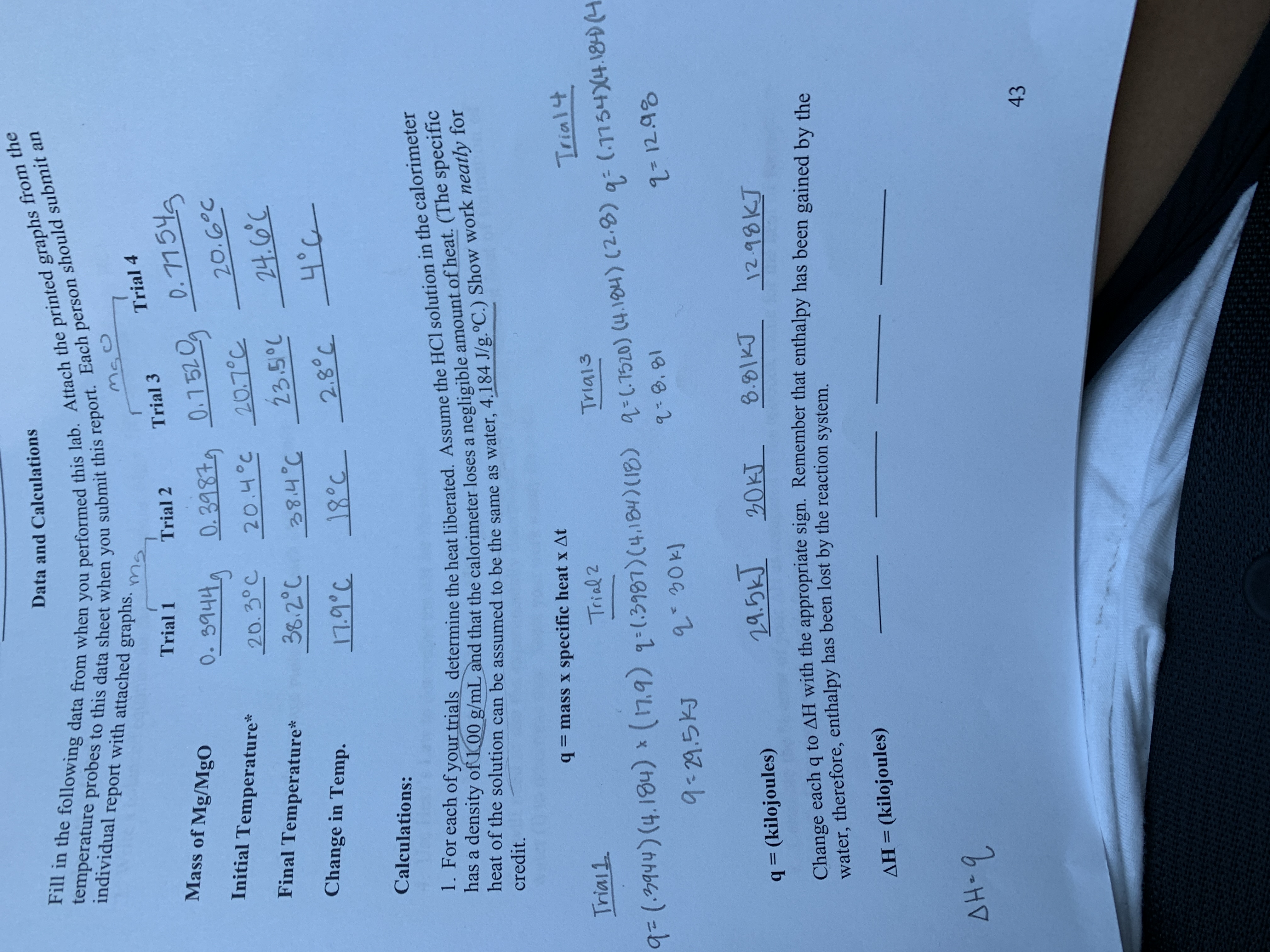
Chemistry
10th Edition
ISBN: 9781305957404
Author: Steven S. Zumdahl, Susan A. Zumdahl, Donald J. DeCoste
Publisher: Cengage Learning
expand_more
expand_more
format_list_bulleted
Question
Can you help me on the part that says change each q to delta h? The data is on the top of the page

Transcribed Image Text:Data and Calculations
Fill in the following data from when you performed this lab. Attach the printed graphs from the
temperature probes to this data sheet when you submit this report. Each person should submit an
individual report with attached graphs.
Trial 4
Trial 1
Trial 3
Trial 2
Mass of Mg/MgO
0.344 0.398 0.1520 D.115
Initial Temperature*
20.6°c
20.4°c 20.7°C
23.5°C
20. 3°C
Final Temperature*
24. 0c
36.2°C
Change in Temp.
2.80c
_18°८ ।
Calculations:
1. For each of your trials determine the heat liberated. Assume the HCl solution in the calorimeter
has a density of 100 g/mL and that the calorimeter loses a negligible amount of heat. (The specific
heat of the solution can be assumed to be the same as water, 4.184 J/g.°C.) Show work neatly for
credit.
mass x specific heat x At
Trial4
Trial1
Trial 2
Triai3
(.1154)4.180H
9(.9444) (4.184) (7.9) 1:13997) (4.184) (18) a-1520) (4.104) (2.8)
8.81
2- 12.98
9-29.5KJ
19.5k 20KT
8.81KJ
12.98KJ
=(kilojoules)
Change eachq to AH with the appropriate sign. Remember that enthalpy has been gained by the
water, therefore, enthalpy has been lost by the reaction system.
AH (kilojoules)
AH-9
43

Transcribed Image Text:Calculations:
1. For each of your trials determine the heat liberated. Assume the HC1 solution in the calorimeter
heat of the solution can be assumed to be the same as water, 4.184 J/g.°C.) Show work neatly for
has a density of 00 g/mL and that the calorimeter loses a negligible amount of heat. (The specific
credit.
=mass x specific heat x At
Triai1
Trial4
Trial 2
Tria13
(1754)4.1840
9(9944) (4.184) (17.9) 1-(.3987) (4.184) (18) C7520) (4.104) (2.0) q
2- 12.98
9-29.5KJ
-8,81
q= (kilojoules)
29.5kJ
20KT
8.81KJ
12.99KJ
Change each q to AH with the appropriate sign. Remember that enthalpy has been gained by the
water, therefore, enthalpy has been lost by the reaction system.
AH=(kilojoules)
1
AH-2
43
Expert Solution
This question has been solved!
Explore an expertly crafted, step-by-step solution for a thorough understanding of key concepts.
This is a popular solution
Trending nowThis is a popular solution!
Step by stepSolved in 2 steps with 1 images

Knowledge Booster
Learn more about
Need a deep-dive on the concept behind this application? Look no further. Learn more about this topic, chemistry and related others by exploring similar questions and additional content below.Similar questions
- Need help, pleasearrow_forwardItem 10 10 of 33 Complete I Review | Constants I Periodic Table Part A The compound MgCl2 is named dimagnesium chloride. magnesium chlorine. magnesium (II) chloride. magnesium dichloride. magnesium chloride.arrow_forwardU16HW Question 11 Homework • Unanswered Fill in the Blanks Type your answers in all of the blanks and submit Calculate the appropriate H30+ or OH for the conditions shown below at 25 °C. Type your answer here If the OH= 2.37E-07 M, then the (H30+= M If the [H30+= 8.33E-09 M, then the OH"= Type your answer here Submit your answer using e notation. For example 1.2x10 2would be 1.2e-02 3 Fullscn 1 Submi Unanswered 9:20 PM 5/9/2021 40 4+ "prt sc 144 delete home end 6. 8. 9. num backspace lock home K enter pause ↑ shift endarrow_forward
- I need help filling in the tablearrow_forward20 cm3 of a gaseous hydrocarbon required 90 cm3 of oxygen for complete combustion. Both volumes were measured under the same conditions.The hydrocarbon must be?arrow_forwardCan someone please check to see if I did this correctly? I feel like o light be doing that last part of c wrong which would also make d wrong. Thank you!arrow_forward
- Question 34 A person drinks 1.50 kg of water (H2O) per day. How many moles is this? (Show your work!) For the toolbar, press ALT+F10 (PC) or ALT+FN+F10 (Mac). 10ntarrow_forwardOH Ph Br 2 1. Mg 2. CH3COCH3 3. H3O+ Br 1. 2 Mg. 2. CH3CO2CH3 3. H3O+ Br 1. Mg 2. CH2O 3. H3O+ Br 1. Mg 2. ethylene oxide 3. H3O+ at least one jarrow_forward
arrow_back_ios
arrow_forward_ios
Recommended textbooks for you
 ChemistryChemistryISBN:9781305957404Author:Steven S. Zumdahl, Susan A. Zumdahl, Donald J. DeCostePublisher:Cengage Learning
ChemistryChemistryISBN:9781305957404Author:Steven S. Zumdahl, Susan A. Zumdahl, Donald J. DeCostePublisher:Cengage Learning ChemistryChemistryISBN:9781259911156Author:Raymond Chang Dr., Jason Overby ProfessorPublisher:McGraw-Hill Education
ChemistryChemistryISBN:9781259911156Author:Raymond Chang Dr., Jason Overby ProfessorPublisher:McGraw-Hill Education Principles of Instrumental AnalysisChemistryISBN:9781305577213Author:Douglas A. Skoog, F. James Holler, Stanley R. CrouchPublisher:Cengage Learning
Principles of Instrumental AnalysisChemistryISBN:9781305577213Author:Douglas A. Skoog, F. James Holler, Stanley R. CrouchPublisher:Cengage Learning Organic ChemistryChemistryISBN:9780078021558Author:Janice Gorzynski Smith Dr.Publisher:McGraw-Hill Education
Organic ChemistryChemistryISBN:9780078021558Author:Janice Gorzynski Smith Dr.Publisher:McGraw-Hill Education Chemistry: Principles and ReactionsChemistryISBN:9781305079373Author:William L. Masterton, Cecile N. HurleyPublisher:Cengage Learning
Chemistry: Principles and ReactionsChemistryISBN:9781305079373Author:William L. Masterton, Cecile N. HurleyPublisher:Cengage Learning Elementary Principles of Chemical Processes, Bind...ChemistryISBN:9781118431221Author:Richard M. Felder, Ronald W. Rousseau, Lisa G. BullardPublisher:WILEY
Elementary Principles of Chemical Processes, Bind...ChemistryISBN:9781118431221Author:Richard M. Felder, Ronald W. Rousseau, Lisa G. BullardPublisher:WILEY

Chemistry
Chemistry
ISBN:9781305957404
Author:Steven S. Zumdahl, Susan A. Zumdahl, Donald J. DeCoste
Publisher:Cengage Learning

Chemistry
Chemistry
ISBN:9781259911156
Author:Raymond Chang Dr., Jason Overby Professor
Publisher:McGraw-Hill Education

Principles of Instrumental Analysis
Chemistry
ISBN:9781305577213
Author:Douglas A. Skoog, F. James Holler, Stanley R. Crouch
Publisher:Cengage Learning

Organic Chemistry
Chemistry
ISBN:9780078021558
Author:Janice Gorzynski Smith Dr.
Publisher:McGraw-Hill Education

Chemistry: Principles and Reactions
Chemistry
ISBN:9781305079373
Author:William L. Masterton, Cecile N. Hurley
Publisher:Cengage Learning

Elementary Principles of Chemical Processes, Bind...
Chemistry
ISBN:9781118431221
Author:Richard M. Felder, Ronald W. Rousseau, Lisa G. Bullard
Publisher:WILEY